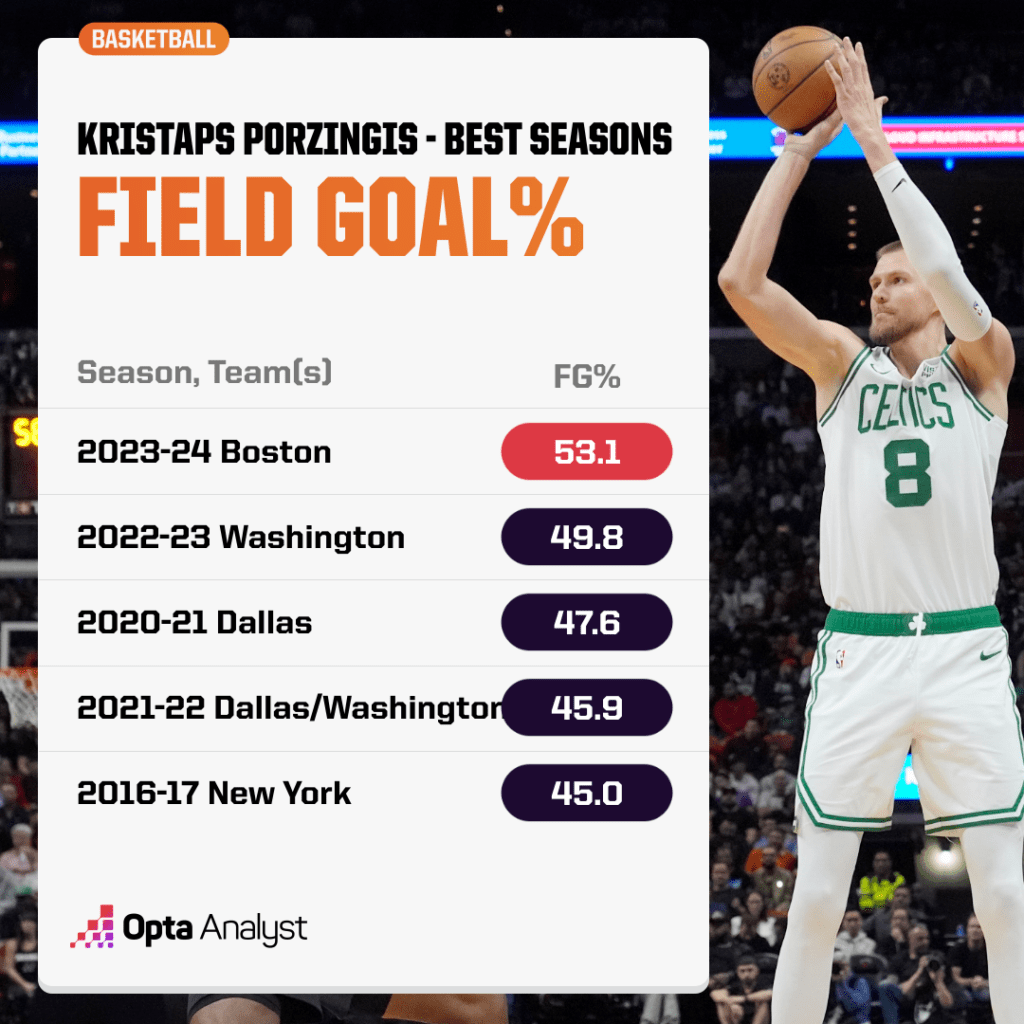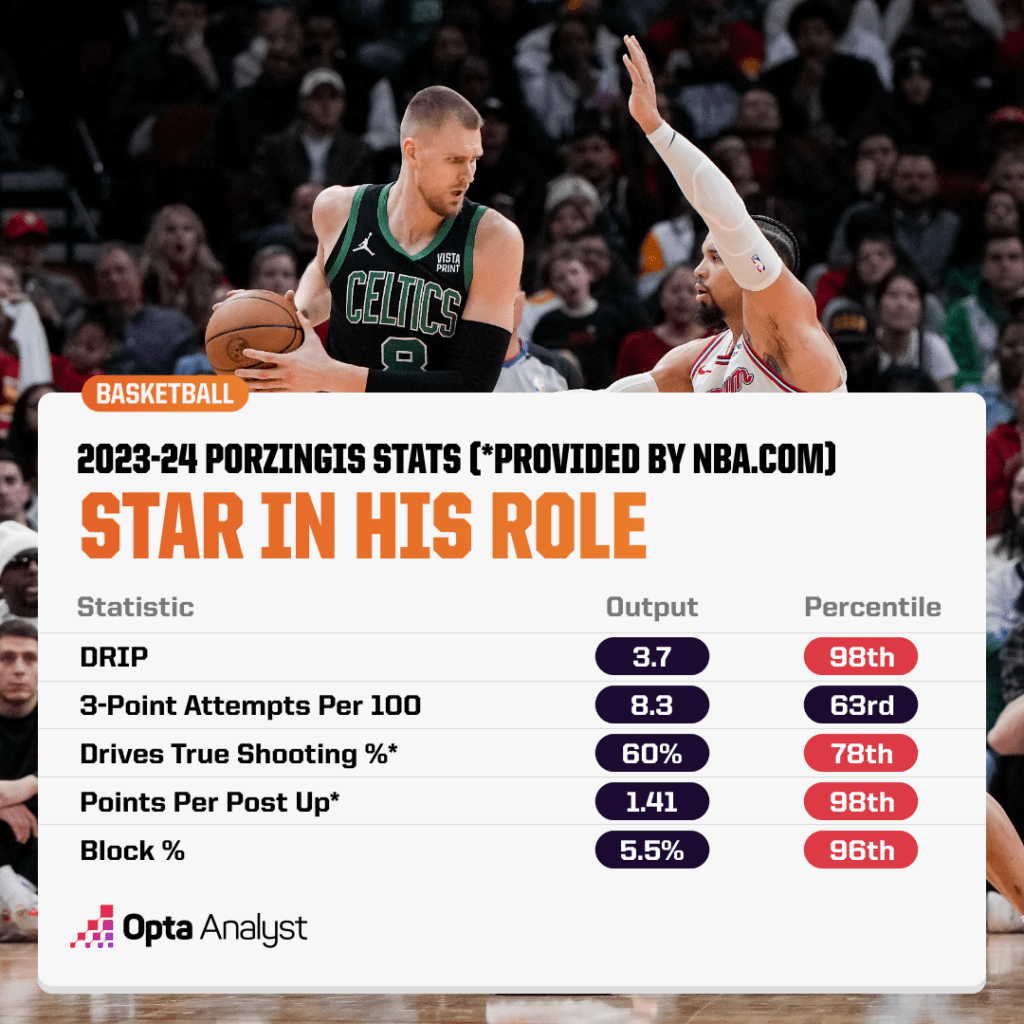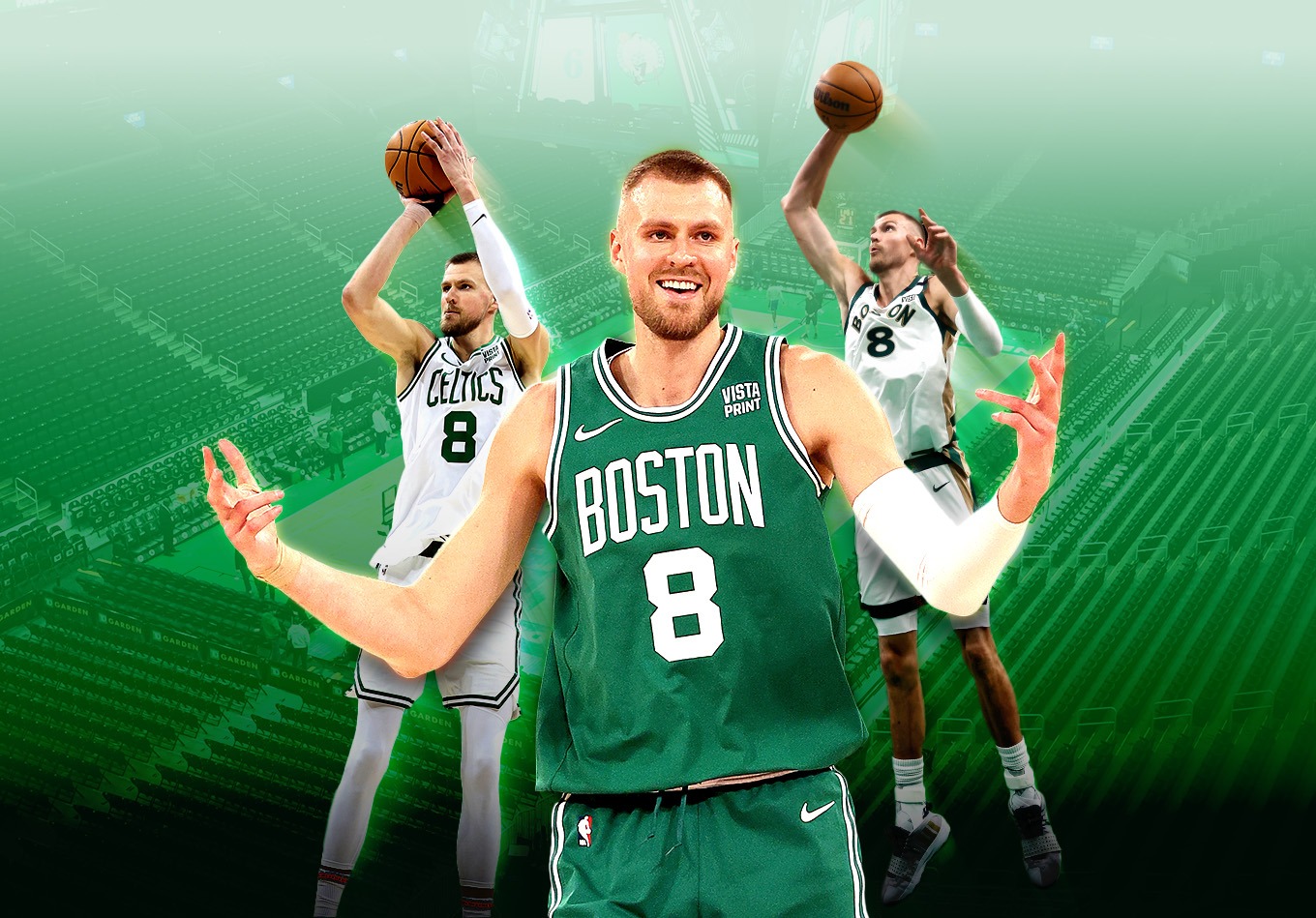Technically speaking, an NBA All-Star Game selection is supposed to signify a player is one of the 25 best in the league that season.
If that’s the case, then why is Boston Celtics power forward Kristaps Porzingis, who ranks 10th in the entire NBA in DRIP, our all-in-one metric that projects a player’s contribution to a team’s plus/minus per 100 possessions, not an NBA All-Star selection or replacement for Sunday’s showcase in Indianapolis (8 p.m. ET, TNT).
Does this mean DRIP overrates him?
Or is Porzingis the biggest NBA All-Star snub?
The Case For Kristaps Porzingis Being an NBA All-Star
DRIP and other one-number statistics like it are primarily designed to explain how good a player is in his particular role. Porzingis is absolutely thriving in his first season with the Celtics.
With Robert Williams III no longer on the Celtics’ roster, Porzingis has been relied on as the team’s primary rim protector. To this point, he’s fulfilled that duty masterfully, evident in a block rate of 5.5%, which places him in the 96th percentile of the NBA.
Porzingis doesn’t boast Williams’ jaw-dropping leaping speed, but he makes up for it with his cartoonish length (7 feet, 6 inches), which allows him to meet drivers at the apex of their jump without hardly leaving his feet.
When Porzingis is on the court, the Celtics’ defensive rating is at 109.4 per 100 possessions (83rd percentile). This is impressive, but it isn’t the 105.0 defensive rating (97th percentile) they had when Williams was on the floor in the 2022-23 season.
With that said, what Porzingis lacks in defensive contributions relative to Williams, he more than makes up for it with what he brings to the table offensively, which includes averages of 20.2 points on a career-high 53.1% field-goal shooting and 6.9 rebounds as well as a 7.4 plus/minus in 29.5 minutes per game.

Last season, the Celtics had arguably the most-talented roster in the NBA (as is probably the case this season), so they didn’t have many major on-court issues. The main one was trying to balance their 5-out spacing with their defense.
When Williams was healthy and on the floor, the Celtics defense was elite. But that boost in fortification came with a loss in spacing because Williams is a non-shooter.
When Al Horford was their nominal center, the Celtics had five players who could credibly shoot 3-pointers. The tradeoff was they no longer had a daunting defender in the paint (Horford is a good, but not elite rim protector).
Porzingis gives the C’s the best of both worlds. He can protect the rim and space the floor. On the surface, his 36.8% 3-point shooting may not seem like much. But when you combine it with his shooting volume (63rd percentile in 3-point attempts per 100) and speedy release, he draws defenders to try to close out on him.

Teams use the pick-and-pop to attack drop coverage. This season, a lot of defenses have countered the pick-and-pop with a “late switch.” With this coverage, the player defending the ball handler veers back and switches onto the popper while the drop defender takes on the ball handler.
This technique works because the big men who execute the pop part of the pick-and-pop normally have slow-shooting motions. Not Porzingis, though, who makes defenses pay for giving him a pocket of space by utilizing a slingshot release.
The beauty of the Porzingis experience is that he’s not just a spot-up spacer – he can attack hard closeouts with dribble drives (78th percentile in true shooting on drives), punctuate lobs (95th percentile in dunks) and be used in off-ball screening actions like a wing forward. The Celtics are consistently running plays that have him coming off curls and down screens.
That all says nothing about Porzingis’ juice as a scorer in the post. According to NBA.com playtype data, he is in the 98th percentile in post-up efficiency, while also being in the 97th percentile in post-up volume.
Despite what some people thought prior to his 2015 NBA Draft, Porzingis isn’t the reincarnation of Dirk Nowitzki with a deep bag of post tricks. In fact, his post arsenal is relatively shallow compared to his contemporaries like Alperen Sengun of the Houston Rockets.
At 7-2, Porzingis has one of the higher release points in the NBA, so instead of worrying about mastering his footwork, he spends half-court possessions hunting mismatches that he can elevate over on the low block.
(Sidebar: Porzingis’ post-up scoring also gives the Celtics’ late-game offense – which has been a fatal flaw for them over the last couple years – another wrinkle they can turn to in order to avoid stagnation.)
So while Porzingis isn’t as venerable of a defender as his predecessor, he raises Boston’s offense to a whole new level (91st percentile in offensive rating when he’s on the floor).
It all screams against an NBA All-Star snub.
The Case Against Kristaps Porzingis Being an NBA All-Star
Do you know what Porzingis and Williams have in common? Injuries.
To be fair, Porzingis doesn’t have it as bad as Williams, but his health has caused him to miss 15 of the Celtics’ 55 games (27%) this season. This probably should not be used as a reason to exclude a player from the All-Star game, but it’s worth noting some people do.
Also, Porzingis shouldn’t be dinged for playing on an outstanding team, but he loses points in the All-Star conversation due to playing a very centralized role on the team.
Take defense, for instance: Porzingis is allowed to operate as a roamer – guarding the opposing team’s least-threatening shooter and sagging off him to protect the paint. He can do this because Boston has physical defenders like Horford and guard Jrue Holiday to handle the bigger brutes Porzingis normally would be matched against if on a less-gifted team.
This brings us to Porzingis’ main weakness: his physicality, or lack thereof. Remember those mismatch post-ups and how effective they can be? They can be neutralized by pushing him off his spots and throwing multiple bodies in his direction.
His inability to get his hands dirty is a big reason Boston’s rebounding numbers are down from last season, including a drop from first to 10th in defensive rebounding percentage. It’s also why the Celtics had to go out and get forward Xavier Tillman from the Memphis Grizzlies at the NBA trade deadline.
The Bottom Line
While the NBA All-Star Game is supposed to be about the top-25 players in the league, it’s more about the top 12 or 14 (when you factor in injury replacements) from each conference because it’s split up by East and West teams.
When you look at it like that, there isn’t much reason why Porzingis wasn’t viewed as a top-14 player in the Eastern Conference, which talent-wise is the weaker of the two conferences.
He doesn’t have the skills that make bad teams good such as on-ball creation and isolation scoring, which contributed to his then-Washington Wizards missing the play-in round of the NBA playoffs last year. But his strengths – rim protection, shooting and off-ball scoring – are what make good teams great.
Porzingis isn’t the biggest NBA All-Star snub in the Eastern Conference – that would be Miami Heat star Jimmy Butler – but he provides legitimate championship value that our DRIP metric is picking up on. And players who provide high-end championship value are the ones who should be getting selected to an All-Star team – not the ones who put up gaudy box score statistics.
For that reason, Porzingis’ omission from the East roster makes him one of the bigger NBA All-Star snubs.
